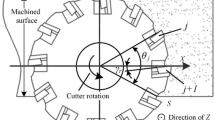Abstract
To improve efficiency and cost performance of cast iron machine tool component fabrication, an alternative process must be developed in order to replace the grinding process, which often causes a bottleneck in production. As an alternative manufacturing approach, this research applies cubic boron nitride (CBN) hard milling operations to eliminate the grinding process in order to improve the overall manufacturing process. A variety of hardened cast iron materials with Al and Mg additives and CBN tool types were prepared and tested based on a design of experimentation (DOE) to observe their effect on surface quality and tool life. Al and Mg were added to raw cast iron to achieve generation of oxide layers at the cutting edge during milling to protect the tool from wear. By executing the DOE, the optimal cutting conditions for achieving the best surface quality were introduced. Also, additional machinability tests were conducted with the optimal conditions in order to evaluate tool wear characteristics and surface quality of the machined workpieces. Based on the observation of the used tool by electron probe micro-analyzer (EPMA), a protective oxide layer of additives was observed at the cutting edge. Hardened cast iron with Al and Mg additives is found to show preferable wear and surface quality characteristics.
Similar content being viewed by others
References
Liu J, Yamazaki K, Ueda H, Narutaki N, Yamane Y (2002) Machinability of pearlitic cast iron with cubic boron nitride (CBN) cutting tools. Transaction of ASME 124:820–832
Furuya S, Ozoe N, Usuki H, Yamane Y (2005) The improvement of machinability of gray cast iron using non-metallic inclusions in high speed cutting. Journal of JSPE 71(6):750–755
Furuya S, Ozoe N, Sekiya K, Yamane Y (2010) The improvement of machinability of gray cast iron using non-metallic inclusions in high speed cutting (2nd report). Journal of JSPE 76(7):775–780
Chandrasekaran H, M'Saoubi R (2006) Improved machinability in hard milling and strategies for steel development. CIRP Annals 55/1:93–96
Shaw MC, Vyas A (1998) The mechanism of chip formation with hard turning steel. CIRP Annals 47(1):77–82
Penalva ML, Arizmendi M, Diaz F, Femandez J (2002) Effect of tool wear on roughness in hard turning. CIRP Annals 51(1):57–60
Soshi M, Yu S, Ishii S, Yamazaki K (2011) Development of a high torque-high power spindle system equipped with a synchronous motor for high performance cutting. CIRP Annals 60(1):399–402
Soshi M, Ishiguro H, Yamazaki K (2009) A study on the development of a multi-purpose spindle for quality productive machining. CIRP Annals 58(1):327–330
Wang Z, Soshi M, Yamazaki K (2010) A comparative study on the spindle system equipped with synchronous and induction servo motors for heavy duty milling with highly stable torque control. CIRP Annals 59(1):369–372
Author information
Authors and Affiliations
Corresponding author
Rights and permissions
About this article
Cite this article
Soshi, M., Fonda, P., Kashihara, M. et al. A study on cubic boron nitride (CBN) milling of hardened cast iron for productive and quality manufacturing of machine tool structural components. Int J Adv Manuf Technol 65, 1485–1491 (2013). https://doi.org/10.1007/s00170-012-4272-3
Received:
Accepted:
Published:
Issue Date:
DOI: https://doi.org/10.1007/s00170-012-4272-3



